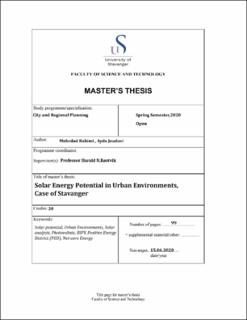| dc.description.abstract | Many cities around the globe are aiming for carbon-neutrality by 2050. Achieving this target requires a massive effort and innovative solutions, especially in the field of producing clean energy in large scales and close to the end-users. In this sense, the vast area of urban surfaces available for PV installations is a promising source of clean energy that can ease the transition towards low carbon urban environments.
The main aim of this study is to assess the solar energy potential for two urban blocks in the city of Stavanger, Norway. The study aims to find out how much clean solar energy could be generated by integrating BIPVs into different building skins in the scale of an urban neighborhood, and then to find out if this energy is sufficient to cover the neighborhood’s energy demand.
For this purpose, an analysis of solar potential is carried out using ArcGIS and DL-light add-on for Sketchup, for two urban blocks at Øvre Holmegate and St.Olavs gate. Then the energy demand for each neighborhood is estimated based on existing statistics. Finally, the possibility of achieving a positive energy district (PED) is studied in four different scenarios.
- In 2020, considering current PV efficiencies and without energy-saving measures
- In 2020, considering current PV efficiencies and with 20% saving target achieved
- In 2030, considering improved PV efficiencies and without energy-saving measures
- In 2030, considering current PV efficiencies and with 32.5% saving target achieved
Findings suggest that in neither of the scenarios, the PED target could be reached, however with better PV efficiencies and bolder energy saving targets, the PED goal is not far to reach. The results also identify the better urban settings for maximizing the solar potential in the city of Stavanger. | en_US |
